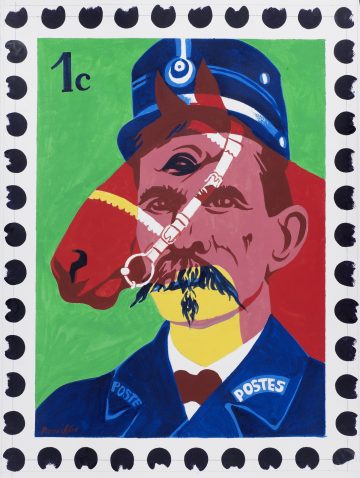Bernard RANCILLAC 1931
Bernard Rancillac was born in Paris in 1931. Initially a drawing teacher, he gave up this profession to devote himself fully to creation. He studied engraving between 1959 and 1962 at S.W. Hayter’s Atelier 17, and won first prize for painting at the Paris Biennial in 1961. From 1963 onwards, he founded the new Figuration Narrative, a movement born of the confrontation between consumer images and shocking press photographs of the tense international climate (Algerian war, Cold War, Vietnam war). Rejecting abstract art, he presented a French-style Pop Art that was more cultivated, critical and political. He took images from the contemporary world and turned them on their head to show their excesses and absurdities. Inspired by comic strips, his characters were exuberant and colourful, often with a rakish smile.
In 1964, he organised the exhibition Mythologies quotidiennes at the Musée d’art moderne de la ville de Paris. His first retrospective exhibitions were held in 1969 in Vitry-sur-Seine and at the museums of Saint Etienne and Brest. In 1999, his works were shown at MoMA in New York (USA) as part of the Pop Impressions exhibition, and in 2001, the Musée national d’art moderne centre Georges Pompidou exhibited his creations as part of the event Les années Pop. His works are held in many institutions, including the Fine Arts Museums of Lyon and Nantes, as well as in Sweden, Holland, Portugal and at the MoMA in New York (USA).
Hommage au Facteur Cheval (fac-similé) 2005
In Hommage au Facteur Cheval, produced for the Avec le facteur Cheval exhibition at the Musée de la Poste, the artist drew inspiration from a portrait photographed in 1905. Postman Cheval is painted in the bright colours characteristic of Bernard Rancillac’s style. With his kepi on his head, he wears his rural postman’s outfit. Unlike the photograph, the postman is looking at us proudly. The drawing of a red horse merges with his moustachioed face. In a humorous reminder of his name, this tangle also gives rise to a third eye on his forehead. Was Postman Cheval a visionary? There’s no doubt that his imagination fuelled his construction, in which fairies, pilgrims, animals and other creatures live side by side. On the north facade of his palace, he wrote: “From a dream I brought forth the queen of the world”. The work is signed in the lower left-hand corner of the composition and, like the indentations on a stamp, its contours recall the double life of the naive builder.

